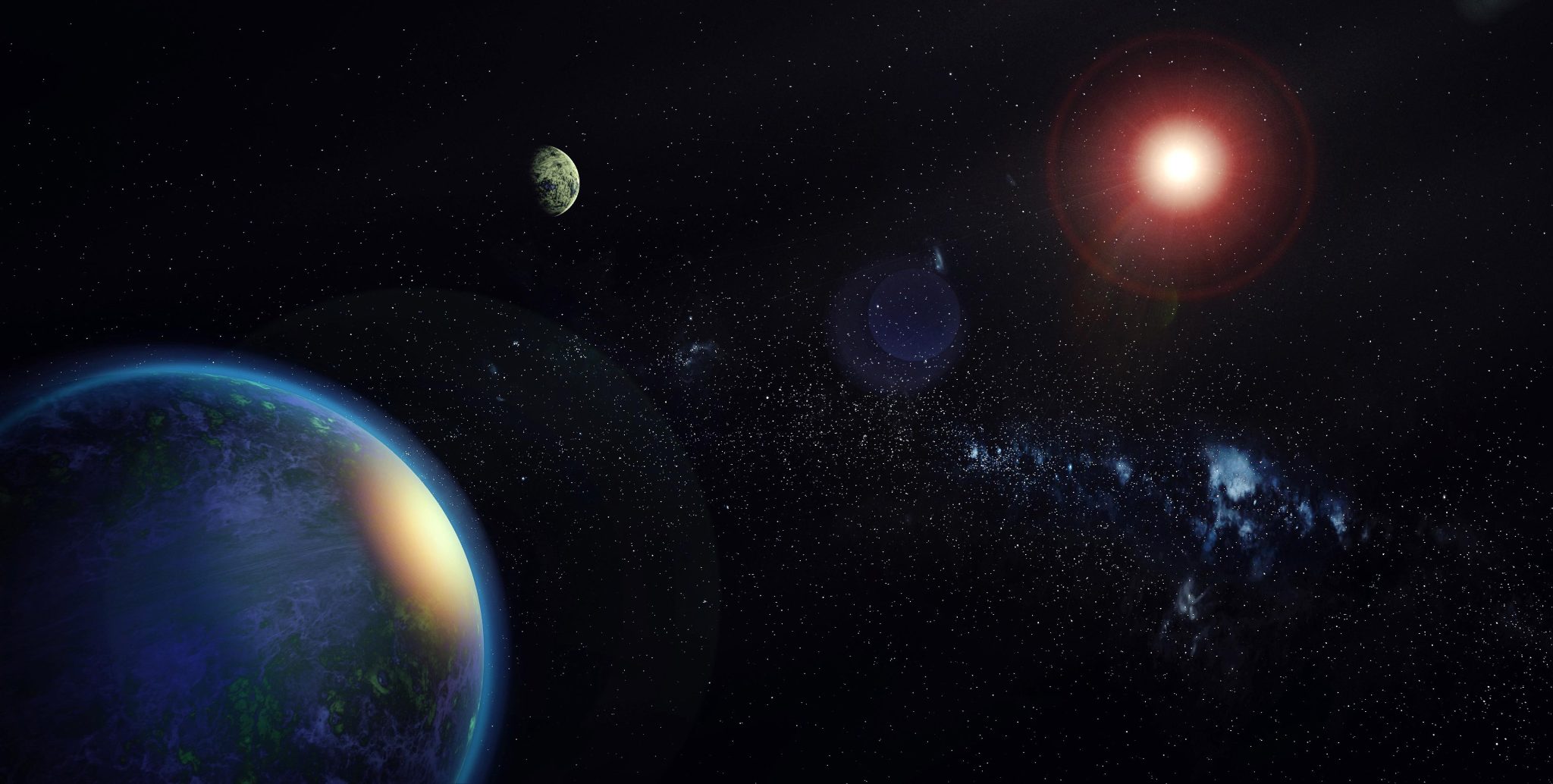
Posted on 12/27/2022 9:21:12 AM PST by Red Badger

Two Earth Mass Planets Orbiting Star GJ 100 Artist’s impression of two Earth-mass planets orbiting the star GJ 1002. Credit: Alejandro Suárez Mascareño and Inés Bonet (IAC)
**************************************************************************
An international scientific team led by researchers at the Instituto de Astrofísica de Canarias (IAC) has discovered the presence of two planets with Earth-like masses in orbit around the star GJ 1002, a red dwarf not far from the Solar System. Both planets are in the habitability zone of the star
“Nature seems bent on showing us that Earth-like planets are very common. With these two we now know 7 in planetary systems quite near to the Sun” explains Alejandro Suárez Mascareño, an IAC researcher, who is the first author of the study published in the journal Astronomy & Astrophysics.
The newly discovered exoplanets orbit the star GJ 1002, which is at a distance of less than 16 light years from the Solar System. Both of them have masses similar to that of the Earth, and they are in the habitability zone of their star. GJ 1002b, the inner of the two, takes little more than 10 days to complete an orbit around the star, while GJ 1002c needs a little over 21 days. “GJ 1002 is a red dwarf star, with barely one-eighth the mass of the Sun. It is quite a cool, faint star. This means that its habitability zone is very close to the star” explains Vera María Passegger, a co-author of the article and an IAC researcher.
The proximity of the star to our Solar System implies that the two planets, especially GJ 1002c, are excellent candidates for the characterization of their atmospheres based either on their reflected light, or on their thermal emission. “The future ANDES spectrograph for the ELT telescope at ESO in which the IAC is participating, could study the presence of oxygen in the atmosphere of GJ 1002c” notes Jonay I. González Hernández, an IAC researcher who is a co-author of the article. In addition, both planets satisfy the characteristics needed for them to be objectives for the future LIFE mission, which is presently in a study phase.

GJ 1002 System Habitability Zone Infographic Infographic comparing the relative distance between the discovered planets and their star with the inner planets of the Solar System. The region marked in green represents the habitable zone of the two planetary systems. Credit: Design: Alejandro Suárez Mascareño (IAC). Planets of the Solar System: NASA
***********************************************************************
The discovery was made during a collaboration between the consortia of the two instruments ESPRESSO and CARMENES. GJ 1002 was observed by CARMENES between 2017 and 2019, and by ESPRESSO between 2019 and 2021. “Because of its low temperature the visible light from GJ 1002 is too faint to measure its variations in velocity with the majority of spectrographs,” says Ignasi Ribas, researcher at the Institute of Space Sciences (ICE-CSIC) and director of the Institut d’Estudis Espacials de Catalunya (IEEC). CARMENES has a sensitivity over a wide range of near-infrared wavelengths which is superior to those of other spectrographs aimed at detecting variations in the velocities of stars, and this allowed it to study GJ 1002, from the 3.5m telescope at Calar Alto observatory.
The combination of ESPRESSO, and the light-gathering power of the VLT 8m telescopes at ESO allowed measurements to be made with an accuracy of only 30 cm/sec, not attainable with any other instrument in the world. “Either of the two groups would have had many difficulties if they had tackled this work independently. Jointly we have been able to get much further than we would have done acting independently” states Suárez Mascareño.
Reference:
“Two temperate Earth-mass planets orbiting the nearby star GJ 1002” by A. Suárez Mascareño, E. González-Alvarez, M. R. Zapatero Osorio, J. Lillo-Box, J. P. Faria, V. M. Passegger, J. I. González Hernández, P. Figueira, S. Sozzetti, R. Rebolo, F. Pepe, N. C. Santos, S. Cristiani, C. Lovis, A. M. Silva, I. Ribas, et al., Accepted on 21 November 2022, Astronomy & Astrophysics.
DOI: 10.1051/0004-6361/202244991
Other members of the IAC who have collaborated in this publication are the researchers Rafael Rebolo López, Víctor Sánchez Béjar and Enric Pallé.

That is a faith based belief.
One of my favorite movies, and scenes. The best one, hands down, was “Consider that a divorce.”
Mass and orbits in an “habitable zone” alone do not define the necessities of being an “Earth like” planet. Even the addition of spectrum of reflected light and “thermal readings” do not provide anything near sufficient data to refer to the planets as “Earth like”.
Far too too many psuedo-science reports are becoming representatives of the non-science of mere wishful thinking.
So is Mayhem.
Common sense, not faith.
The radiation alone I would think would kill anything on the planet.
And if it has no magnetic field, all bets are off................
I think you can kiss off complex life on planets and star systems like this. With a star this cool, the habitable zone must be very close to the star to have liquid water. This means the plane is in tidal lock - one side always faces the star - much like only one side of our moon faces Earth. Basically, this means one side only is hot, the other never sees the light of day and is very cold, and where they meet is an area of violent weather.
A crappy place to live.
Point made - thanks for the back up!
“Nature seems bent on showing us that Earth-like planets are very common.”
This statement is entirely political which is to say not at all scientific.
It’s no surprise this claim is at the very top of the article.
The purpose of this article is to undermine Biblical faith and to promote communism and Satanism.
This means the orbiting planets are probably tidally locked to the star, which means one side is always facing the star and the other side is facing away. It's unlikely these are "habitable" or "Earth-like" planets.
But the hype should keep the funding going.
damn, i’ll prolly be busy...
dude, it’s the wording, not the distance...
16? Even0.01 light years will require 1000 generations born in rocket ships to reach the planet. Can you imagine in-breeding for 1000 generations?
They are not impossible to get to, for someone with sufficient patience.
It may take hundreds of years before a launched probe sends back data, but not “impossible”.
XO Planet Ping!................
“16 light years is what it says in the article”
Practically walking distance.
“186k m/sec. It’s the law!” [Delta 21, post 11]
Respectfully suggest rechecking your units.
Velocity of light in a vacuum is a little under 300,000,000 m/sec. That’s over 186,000 statute miles per second.
Yeah you ain’t kidding. Better bring along a book to read.
And everybody make sure to go to the bathroom before we leave!

The above image has a very misleading label in the article. It doesn't show relative distance, but instead where the various planets fall in the habitable zone around their respective stars.
The innermost of the two planets (b) is actually about 20x closer to the red dwarf than Earth is to the sun. The other is about 13x closer.
Disclaimer: Opinions posted on Free Republic are those of the individual posters and do not necessarily represent the opinion of Free Republic or its management. All materials posted herein are protected by copyright law and the exemption for fair use of copyrighted works.